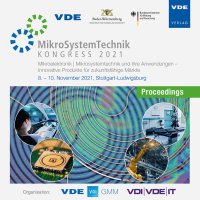Radiation Resistant High-temperature Bolometer Sensors for Fusion Experiments
Konferenz: MikroSystemTechnik Kongress 2021 - Kongress
08.11.2021 - 10.11.2021 in Stuttgart-Ludwigsburg, Deutschland
Tagungsband: MikroSystemTechnik Kongress 2021
Seiten: 4Sprache: EnglischTyp: PDF
Autoren:
Schmitt, Stefan; Detemple, Peter (Fraunhofer IMM, Mainz, Germany)
Meister, Hans; Penzel, Florian (Max-Planck Institute for Plasma Physics, Garching, Germany)
Ingesson, Christian; Walach, Ulrich (F4E, Barcelona, Spain)
Inhalt:
In fusion research, the measurement of the radiation power is a versatile tool to control and optimize the plasma that is magnetically confined inside a vacuum vessel. Fusion facilities such as ITER, Wendelstein 7-X, ASDEX-Upgrade and others, rely on the use of bolometer sensors that absorb the radiation emitted from the plasma in an absorber structure. The resulting temperature change can be detected electrically with precise thermal resistors. Apart from measuring over a wide spectral range starting at near infrared up to x-rays of a few 10 keV, the bolometers need to withstand radiation damage under strong neutron fluxes (e.g. up to 0.3 displacements-per-atom for ITER) and high thermal loads of up to 400 °C. In order to fulfil these extremely harsh operation conditions, all materials and processes involved have to be tested and selected carefully. Two miniaturized MEMS-based bolometer sensor embodiments capable of fulfilling these de-manding requirements have been developed. The first embodiment uses a very thin (3 µm), freestanding silicon nitride membrane which carries a 20 µm thick gold absorber. On the opposite side of the absorber, a precise metal resistor is placed for detection of the temperature increase under irradiation. In order to assure sufficient mechanical stability, a rigid silicon frame supports the membrane. The second approach is based on a thin (20 µm) zirconia (ZrO) substrate which again carries on one side a gold absorber and on the opposite side a metal resistor. For both approaches manufacturing, bench testing and first results of characterization will be presented. Prototypes from both approaches routinely have closely balanced resistor values and a high temperature coefficient of resistance (TCR), and have been demonstrated to routinely withstand repeated thermal cycling up to 400deg C.


